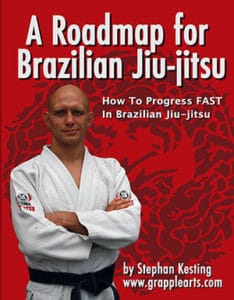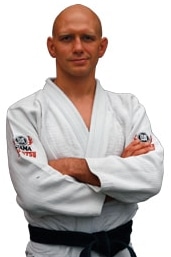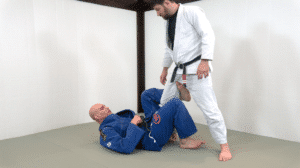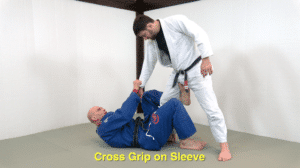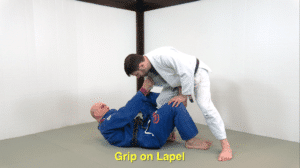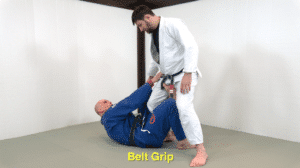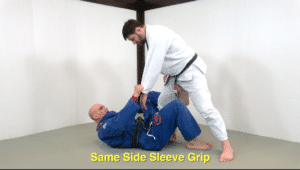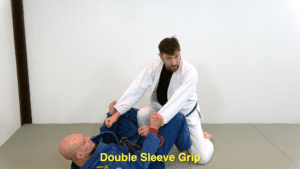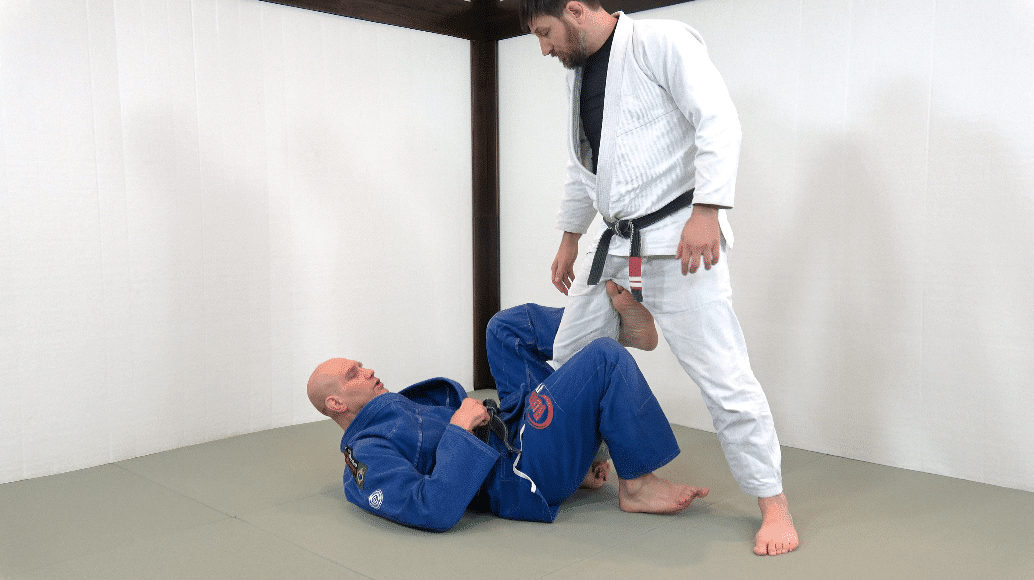
The de la Riva guard is very powerful and effective form of guard, often used in modern BJJ. It can be an intimidatingly complex position though, with a large number of grips, variations, sweeps, attacks and other techniques available for you to use.
The point of today’s article is to simplify the de la Riva guard for you. The way we’re going to do that is by breaking it down on the basis of the four fundamental grips you should learn first. As you’ll see, your grip will determine many of your offensive and defensive options in the de la Riva guard.
(I wish I’d had someone break it down for me like this when I started playing with the de la Riva.)
To start with, here’s a video I shot recently with BJJ black belt (and friend) Jeff Meszaros taking you through the most important gripping options for the de la Riva guard.
That video is immediately below, or you can scroll further down for a more detailed breakdown of each options discussed in the video!
First, What is the de la Riva Guard?
The de la Riva guard is a form of open guard named after BJJ legend Ricardo de la Riva.
It involves the use of the ‘de la Riva hook’, which is when your leg wraps around the outside of your opponent’s leg with the foot inserted between your opponent’s legs. In the photo above you can see how my left leg is wrapped around Jeff’s leading right leg with my foot reappearing inside his legs.
Most typically your free hand – the hand on the side of your wrapping leg – will control your opponent’s foot at the heel to stop him from running away. In the case of the photo above my left hand (which you can’t really see) is controlling Jeff’s right heel.
The de la Riva guard can be used against someone who is kneeling, but it’s even more useful against a standing opponent. That’s because a standing opponent is very mobile, and if you don’t wrap him up somehow then he can just sprint past your legs and pass your guard.
In the video below BJJ black belt world champion Brandon Mullins gives you a great introduction to the de la Riva guard that you should definitely watch if you’re not already very confident in your de la Riva abilities…
The Four and a Half Fundamental de la Riva Guard Grips
There are four fundamental grips you need to learn when you’re first playing with the de la Riva.
These are the building blocks, and will form the foundation for other, more advanced grips. Each grip has a different set of associated attacks with it, poses different problems for your opponent, and hinders certain kinds of guard passes more than others.
Are there more than these four options? Of course! But these are the ones that everyone needs to know before they go off and develop fancy variations based on alternate grips.
The grips we’re going to discuss today include:
- The Cross Sleeve Grip
- The Lapel Grip, and it’s close cousin, the Belt Grip
- The Same Side Sleeve Grip
- The Double Sleeve Grip
The exact grip that you end up using depends in part on your preferences and your favourite attacks, but it also depends on what he gives you.
Jiu-jitsu is a reactive sport, so if he’s fighting like crazy to stop you from controlling one sleeve then often he exposes the other arm, allowing you to switch back and forth between grips 1 and 3. Or if he were to keep both hands very high and out of reach then you your best option might be to grab his lapel or his belt (grip 2).
De la Riva Guard Fundamental Grip 1: The Cross Sleeve Grip
In the cross sleeve grip you control his heel with one hand and grip his cross sleeve with the other.
In the photo above I’m controlling Jeff’s heel with my left hand, and gripping his right sleeve at the cuff with my own right hand (crossing my body in the process).
There are many different attacks you can use from this position, but one of the most common is taking the back. Because you’re controlling the cross sleeve grip it’s hard for him to stop you from turning his body using a combination of the pull on his arm and the extension of your de la Riva hooking leg. A good example of this attack can be seen in the video below…
De la Riva Guard Fundamental Grips 2 and 2 1/2: The Lapel and/or Belt Grips
For these two variations you control his heel with one hand and grip his lapel or his belt with the other.
In the photos above I’m controlling Jeff’s heel with my left hand, and gripping his lapel, and then his belt, with my right hand.
These two grips are similar in the sense that you have many of the same attacks available to you. However there are subtle differences too…
For example the lapel grip is all about posture control: by controlling his upper body and pulling him forward you’re preventing him from establishing posture. You’re also loading his weight up onto your legs allowing you to off balance him and even lift him above you using both of your legs in concert.
The belt grip, on the other hand, gives you somewhat less control over his posture, but sets you up very nicely for the berimbolo attack. Some competitors (like the Miyao brothers) have made the berimbolo an absolutely central part of your game with a tremendous number of refinements and variations.
For the easiest way to do the berimbolo, either from the belt or the lapel grip, check out this article or click play on the video immediately below…
De la Riva Guard Fundamental Grip 3: The Same Side Sleeve Grip
In this gripping variation you control his heel with one hand and grip his same side sleeve with the other.
In the photo above I’m controlling Jeff’s heel with my left hand, and gripping his left sleeve at the cuff with my right hand (the side closest to my right hand).
This grip twists his body in a very different way from the cross sleeve grip we covered in option 1. Here your grip actually prevents you from moving towards his back, but on the other hand it sets up some very powerful sweeps that are hard for your opponent to resist and to effectively break fall for.
BJJ word champion Brandon ‘Wolverine’ Mullins has made this grip central to his de la Riva guard game, and teaches one of these powerful sweeps (the ‘ball and chain’ sweep) in the video below. Go slow when you’re practising this sweep with your training partners, because you don’t want to piledrive their entire bodyweight onto their unprotected shoulder!
De la Riva Guard Fundamental Grip 4: The Double Sleeve Grip
In this grip you’re controlling both of his sleeves with both of your hands and there is no hand on his heel.
Because you’re not controlling his heel you’re typically going to use this gripping position when your opponent is kneeling down on one knee. When he’s kneeling he’s not as mobile as when he’s up on both feet, meaning that you have a little more time to set up your attacks and block his guard pass attempts.
With both of his arms controlled you have a lot of options. For example you can set up both the ball and chain sweep or the basic kick-the-leg-out sweep (shown in the video embedded at the top of this page), or you can set up some truly elaborate traps and attacks for your opponent.
To give you a taste of the power of the double sleeve grip de la Riva guard, here’s the man Ricardo de la Riva himself teaching a cool sweep from this position.
P.S. Are you on my BJJ email newsletter yet? I send people on that list tons of in-depth information about techniques and training methods, and every day I receive positive feedback from some email that I have sent out. It’s easy (and completely free) to sign up: simply enter your email in the box below, and then click ‘sign me up now’ to join and download A Roadmap for BJJ!
